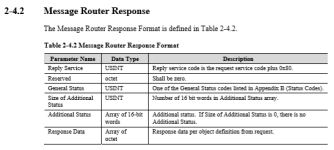Mark Short
Member
I am developing software to communicate with Allen Bradley PLCs via EtherNet/IP.
I'm very much in the foothills at the moment, trying to figure out how connect to the PLC using the Forward Open message, by looking at Wireshark traces between Rockwell's Connected Components Workbench and a Micro 850 device. The Forward Open request makes sense, but the Forward Open response has a Request Path in it that I can't make sense of. It appears after the Additional Status Size field. The definition of the Message Router Response in the CIP spec doesn't include a path (but the Message Router Request does). After the Request Path comes the Forward Open Response bytes, which is what I expect to see.
It does occur to me that my copy of the spec might be out of date. I have Volume 1 Common Industrial Protocol (CIP), Edition 3.3, dated November 2007. (I've looked on the OVDA website, but doesn't indicate the latest version is.) Or is it that I just haven't understood the gnarly structure of CIP messages correctly?
I'm very much in the foothills at the moment, trying to figure out how connect to the PLC using the Forward Open message, by looking at Wireshark traces between Rockwell's Connected Components Workbench and a Micro 850 device. The Forward Open request makes sense, but the Forward Open response has a Request Path in it that I can't make sense of. It appears after the Additional Status Size field. The definition of the Message Router Response in the CIP spec doesn't include a path (but the Message Router Request does). After the Request Path comes the Forward Open Response bytes, which is what I expect to see.
It does occur to me that my copy of the spec might be out of date. I have Volume 1 Common Industrial Protocol (CIP), Edition 3.3, dated November 2007. (I've looked on the OVDA website, but doesn't indicate the latest version is.) Or is it that I just haven't understood the gnarly structure of CIP messages correctly?






